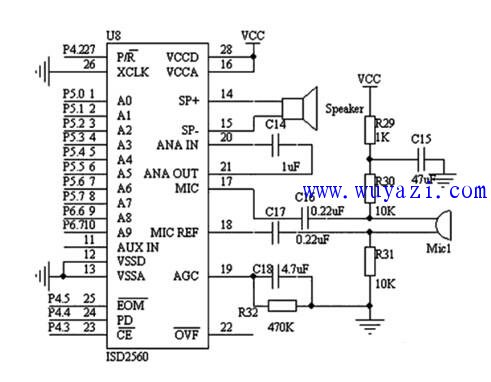Blood glucose test circuit analysis: To detect the number of free electrons produced by the reaction between glucose oxidase and glucose, a fixed bias voltage must be applied across the electrodes. The current generated by this bias voltage is then measured to determine the concentration of blood glucose. The required bias voltage varies depending on the chemical materials used on the test strip. In this design, the bias voltage is obtained by dividing the voltage from the VLL1 pin of the liquid crystal drive module using a resistor divider network. This results in a bias voltage of approximately 273mV. The current generated by the reaction of normal human blood with glucose oxidase typically ranges from nanoamperes (nA) to microamperes (μA). To convert this small current into a measurable voltage, a signal conversion and voltage amplification circuit is essential.
Figure 2 illustrates an amplifier circuit implemented using the comparator module of the LL16 chip. The positive input of the comparator is connected to the 273mV bias voltage, which is derived from the VLL1 voltage through a three-resistor divider consisting of R6, R5, and R4. A filter capacitor, C4, is used to suppress high-frequency noise from the VLL1 supply, ensuring a stable bias voltage. The negative input of the comparator is connected to the enzyme electrode on the test strip, specifically the fourth pin. The flow of free electrons driven by the bias voltage acts like a variable resistor, Rx. The lower the resistance value of Rx, the higher the blood glucose concentration. By measuring this resistance, the mass concentration of glucose can be calculated.

In-depth data analysis reveals that the resistance of Rx typically falls within the range of 18kΩ to 300kΩ. The minimum voltage of the 3V battery is about 2.3V. To ensure that the comparator’s output does not exceed the battery’s minimum voltage, the gain of the amplifier circuit must be limited. Choosing R3 as 120kΩ ensures that when the tested resistance is 18kΩ, the amplifier output remains at 2.1V, safely below the battery's minimum voltage. Since the core component of the amplifying circuit is a comparator, the output is a square wave signal. To smooth this signal, a first-order low-pass filter composed of resistor R1 and capacitor C1 is used to remove high-frequency harmonics, resulting in a more stable DC output.
To prevent the comparator output from exceeding the positive rail, R1 should not be too large. However, for effective filtering, it shouldn't be too small either. A moderate value of 15kΩ was chosen. For optimal high-frequency filtering, C1 should not be too small. However, if C1 is too large, it may cause excessive amplitude on the negative side of the comparator. After testing, a 1μF capacitor was found to provide the best overall performance.
Although the R1-C1 filter reduces the high-frequency components of the comparator output, some ripple still remains at the positive end of C1. To ensure accurate and consistent glucose measurements, the output of the amplifier circuit is further filtered using R2 and C2. Considering the optimal frequency response of capacitors, C2 was selected as 10μF and R2 as 10kΩ to achieve better filtering and stability.
All Kinds of Lithium Battery,Out Door Power Station,Pack and ESS system.
Lithium Battery, LifePo4, Battery for Home Energy Storage,Data Base
Jiangsu Zhitai New Energy Technology Co.,Ltd , https://www.zttall.com